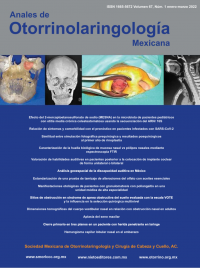
Relationship between the computer tomographic dimensions of the nasal vestibular body with nasal obstruction in adults.
An Orl Mex. 2022; 67 (1): 91-98. https://doi.org/10.24245/aorl.v67i1.7373
Luis Gerardo Vargas-Cárdenas,1 Fernando Juan Ramírez-Oropeza,2 Enrique Girón-Archundia,2 Omar Gómez-Monterrosas,3 Juan Antonio Lugo-Machado4
1 Otorrinolaringólogo y cirujano de cabeza y cuello. Miembro del curso de alta especialidad en rinología y cirugía facial.
2 Otorrinolaringólogo y cirujano de cabeza y cuello. Profesor adjunto del curso de alta especialidad en rinología y cirugía facial.
Universidad Nacional Autónoma de México.
3 Asesor experto metodológico.
4 Otorrinolaringólogo y cirujano de cabeza y cuello, subespecialista en Otorrinolaringología pediátrica. Profesor adjunto del servicio de Otorrinolaringología y cirugía de cabeza y cuello, Centro Médico Nacional del Noroeste, Obregón, Sonora, México.
Resumen
OBJETIVO: Determinar la asociacion entre el tamaño tomografico del cuerpo vestibular nasal y la obstrucción nasal en adultos.
MATERIALES Y MÉTODOS: Estudio observacional analítico, retrospectivo de casos y controles, efectuado en el Hospital Ángeles de Puebla, México, que incluyó pacientes adultos a los que se les solicitó una tomografía simple de nariz; se incluyó un grupo que refirió obstrucción nasal y otro grupo control sin obstrucción nasal; se midió el área del cuerpo vestibular por tomografía en formato digital, en cortes coronales y se compararon los resultados de ambos grupos, así como la existencia o no de rinitis con o sin tratamiento.
RESULTADOS: Se incluyeron 23 pacientes de los que se recolectó la información del expediente clínico. Del total de pacientes, 10 eran hombres y 13 mujeres. La edad promedio fue de 28.8 ± 10.2 años; 10 pacientes refirieron síntomas de rinitis. Se encontró una correlación positiva moderada entre la obstrucción nasal y el ancho del cuerpo vestibular nasal (R = 0.79, p < 0.001) y entre la obstrucción nasal y el largo del cuerpo verstibular nasal (R = 0.77, p < 0.001).
CONCLUSIONES: Se encontró relación entre el tamaño del cuerpo vestibular y la obstrucción nasal, esta información nos proporciona una valiosa herramienta diagnóstica preoperatoria en estos pacientes; se requieren estudios complementarios más extensos para aclarar este tema con mayor certeza.
PALABRAS CLAVE: Obstrucción nasal; rinitis; tomografía.
Abstract
OBJECTIVE: To determine the association between the nasal vestibular body’s tomographic size and the presence of nasal obstruction in adults.
MATERIALS AND METHODS: An observational, analytic, retrospective case-control study was done at the Hospital Angeles de Puebla, Mexico, from August to December, 2020. Adult patients with a simple tomography image of the nose were included. A group that reported nasal obstruction was compared with a control group without nasal obstruction. Digital tomography coronal slices measured the vestibular body in both groups. The results of both were compared, as well as the presence or not of rhinitis with or without treatment.
RESULTS: Twenty-three patients were included (10 men and 13 women), for whom a clinical file was collected. The average age was of 28.8 ± 10.2 years. Ten patients reported symptoms corresponding to rhinitis. A moderate positive correlation was found between nasal obstruction and the vestibular body width (R = 0.79, p < 0.001), as well as between nasal obstruction and the length of the nasal vestibular body (R = 0.77, p < 0.001).
CONCLUSIONS: This study shows a relationship between the vestibular body with nasal obstruction. This information provides a valuable preoperative diagnostic tool in these patients. Longer complemental studies are required to elucidate this issue with greater certainty.
KEYWORDS: Nasal obstruction; Rhinitis; Tomography.
Recibido: 26 de enero 2022
Aceptado: 6 de febrero 2022
Este artículo debe citarse como: Vargas-Cárdenas LG, Ramírez-Oropeza FJ, Girón-Archundia E, Gómez-Monterrosas O, Lugo-Machado JA. Dimensiones tomográficas del cuerpo vestibular nasal en relación con obstrucción nasal en adultos. An Orl Mex 2022; 67 (1): 91-98.

